Summer Excursion, 1909
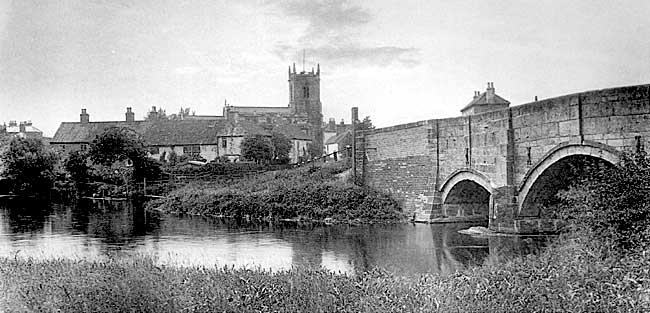
Mattersey village and bridge over the River Idle.
THE prospect of a long day and an early start had the effect of limiting the numbers who attended the summer excursion, which took place on Thursday, 17th June. Nevertheless, about thirty members were present, and an enjoyable day was spent in the northern part of the county, known as the North Clay district, a locality that had not previously been visited by the Society.
A start was made by the Nottingham contingent from Victoria Station at 8 a.m. for Retford, where conveyances took the party to Mattersey, by way of Sutton-cum-Lound, and thence past Blaco Hill, where there used to be traces of earthworks, until a farmstead was erected on the summit by a Mr. Acklom.
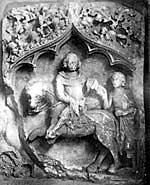
Sculptured panel, "St Martin". Mattersey church.
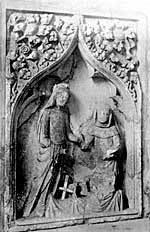
Sculptured panel, "St Helen". Mattersey church.
At Mattersey, a short inspection of the church, dedicated to All Saints, was made under the guidance of the vicar (Rev. J. Kennedy). There are two carved stones built into the wall of the vestry, which were found under the chancel floor in 1804. Upon one is represented St. Martin sharing his coat with a beggar, and upon the other, St. Helen discovering the true Cross. This latter interpretation receives support from the fact that the adjacent priory, from which the stones, no doubt, came originally, was dedicated to St. Helen.
The party here divided, part electing to view the scanty remains of the Gilbertine Priory (the only house of that order in Nottinghamshire), on the banks of the river Idle, half a mile away, whilst the remainder proceeded to Everton.
The Rev. Dr. Scott-Moncrieff, of Blyth, met the visitors at Mattersey and read the following paper, which be had kindly prepared for the occasion.
MATTERSEY PRIORY.
By THE REV. Dr. SC0TT-MONCRIEFF.
The ruined Priory of Mattersey, Mathersey, or Maresey, is situated on the island of that name, and surrounded on three sides by the river Idle. The fourth side is now bounded by a dyke, which no doubt marks the course of an ancient channel of the same river, when, in the old days, it was navigable as far as Bawtry. An ideal spot this for such an establishment, rich water-meadows on the island, light soil requiring plenty of irrigation and receiving it, wooded country teeming with game across the stream, and plenty of fish for Fridays, from the lordly salmon to the humble perch.
At the close of the 12th century, we find a family deriving their name from this place who were lords of Gamston, a village situated a few miles south of Retford. In the year 1192, the head of this house, Roger de Maresey, founded this priory, and endowed it with lands and granges at Mattersey, Thorpe, Gamston, Elkesley, West Retford, Misson, and Boulton. The priory, which was dedicated to St. Helen, is of special interest as belonging to the then lately founded order of Gilbertines, the only monastic order of purely English origin, and for that reason not hostile, as most of the orders were, to the national character of the church, It did not as they did, acknowledge obedience to some grand master in France or Italy, and draw money out of the country to support the dignity of any such foreign potentate. St. Gilbert, rector of Sempringham, in south Lincs., instituted it about the middle of the 12th century. A distinctive feature of the order was that it included both sexes, who resided in distinct buildings, but used one church, in which the nuns were separated from the canons’ part by a central wall. Out of thirteen houses established by St. Gilbert, nine were for both men and women, four for men only. The men followed in the main the rule of St. Austin, with whose splendid foundation at Worksop our monks of Mattersey, no doubt, maintained friendly relationships. The women observed the Benedictine rule. It is easy to understand how such establishments would be keenly overhauled by Cromwell’s paid informers, as likely to yield material for the stories with which they regaled their employer.
Was Mattersey a mixed house or not? Thoroton says it was founded for six Gilbertine canons, but the charter of foundation is not extant, and there is a tradition that Mattersey was a nunnery. Some nuns may have been settled here for a time, but they had certainly disappeared before the house was dissolved.
The order was under the rule of a General Superior, called the Master, or Prior General, who at the time when Mattersey was founded was one Robert of Sempringham, apparently a relative of St. Gilbert, The foundation was not accomplished without friction. The monks of Welbeck considered that some of the donations to the new priory infringed upon their rights, and the question was referred to Pope Celestine III., who appointed a commission to decide the matter. The award which was delivered in the Chapter-house of Blyth, settled the advowsons of the churches of Bolton, Mattersey, Misson, and Gamston, on the Priory of Mattersey; that of Elkesley on the other hand was given to Welbeck.
In the year 1280, a fire broke out in the priory doing great damage. To repair this the tithes of the parish church of Mattersey were made over to the brethren, who were already patrons of the living, which was henceforth served by a vicar.
A charter is extant of the early part of the 14th century granted by Isabel de Chauncy, daughter and heiress of Thomas de Maresey, confirming to the priory the gifts of land and ecclesiastical patronage made by her forefathers, In addition to these, we find the priory possessed of landed property at Pinningley, Sturton, Clayworth, and Wiseton. The prior claimed free warren, or licence to preserve and hunt game in Mattersey and Thorpe, and that he and his men should pass city gates, cross bridges, frequent quays, and traffic in markets and fairs throughout all England, free of toll. Such privileges, ever recurring pinpricks, no doubt were largely instrumental in arousing whatever popular feeling was enlisted in support of the policy of the Great Pillage.
The Priory of Mattersey had its doom pronounced in 1536, by the Act which confiscated the property of all religious houses the income of which did not amount to more than £200 per annum. Our priory was returned at the modest figure of £55 2s. 6d. The blow fell two years later. One of the most active of Cromwell’s inquisitors was a certain Dr. Petre, who, in 1538, seems to have made the houses of the Gilbertine rule the special object of his predatory activities. After destroying the mother house at Sempringham, where Holgate, Bishop of Llandaff, and master of the order, was holding the office of prior in commendam, he proceeded to extirpate the Gilbertines throughout the county of Lincolnshire, and on October 7th, summoned the prior of Mattersey, Thomas Norman, and his four brethren to surrender their buildings to the king. To Thomas a pension of £22 13s, 4d. was allotted, we do not know bow the others fared. Fourteen years later we find that three only were alive to apply for whatever pittance was due to them.
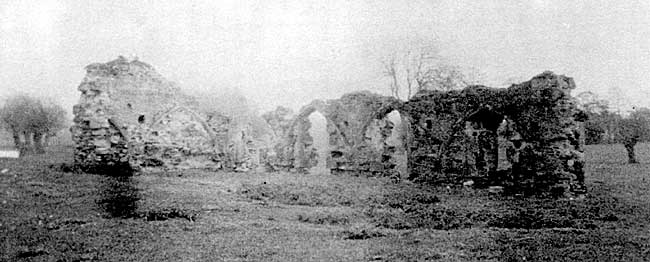
Ruins of Mattersey Priory.
The monastery buildings, the manorial rights, and the rectorial tithes, were granted by the king to Anthony Neville, presumably one of the family who had lately succeeded the Hercys in the lordship of Grove. He built his manor house out of the ruins of the priory. Other portions of the monastic property were allotted to other claimants, the most interesting being that of the grange at Finningley, which in 1576 was granted by Queen Elizabeth to the great sea captain and explorer, Sir Martin Frobisher. Thus the old order changed giving place to the new, and these few stones are all which remain to tell us of the daily worship, simple occupations, and quiet lives of the little band of brethren who served God on the isle of Mattersey.
I believe the remains of a vaulted chamber, pierced with simple trefoil lights, to be those of the refectory, occupying the south side of the cloisters, the pillar and masonry attached to be those of the north-east corner of the cloisters and the lofty mass of masonry in the garden to be part of the church. Interesting indications of the arrangements of houses of the Gilbertine order would be revealed if only the foundations were uncovered.
Passing out of the village of Mattersey, the old 14th century stone bridge over the river Idle was inspected. A large number of the facing stones are incised with masons’ marks, of which the following is a selection :—
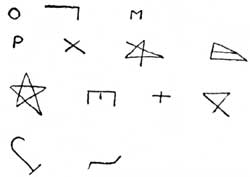
A drive of about a mile and a half brought the party to Everton. The vicar (Rev. F. D. Thompson) met the visitors, and at once proceeded to acquaint them with some of the principal features of interest connected with the church. The vicar’s remarks have been supplemented by the following paper, written by Mr. Harry Gill.
